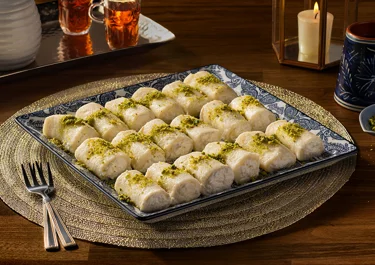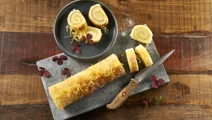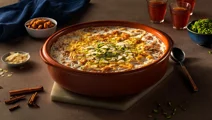Halawet el jibn

Indulge in halawet el jibn, the famous, soft, sweet cheese rolls with grated mozzarella cheese and semolina dough filled with cream and garnished with pistachios and orange blossom flowers. It is a traditional dessert that is very popular during Ramadan. It is an elegant, soft, and sweet bite with the richness of cream perfectly complementing the burst of flavours from orange blossom water, mozzarella cheese, and pistachios. Try this delectable Arabic dessert to pamper and impress your family and guests at iftar.
Ingredients
For the simple syrup:
|
400 g
Sugar
|
|
|---|---|
|
240 ml
Water
|
|
|
1 tbsp
Lemon juice
|
|
|
1 tsp
Orange blossom water (optional)
|
|
|
Pistachios and orange blossom flowers for garnish
|
For the curd:
|
1 litre
Arla Cravendale Whole milk
|
|
|---|---|
|
3 tbsp
Lemon juice or vinegar
|
For the pudding:
|
480 ml
Arla Cravendale Whole milk
|
|
|---|---|
|
3 tbsp
Corn flour
|
|
|
1 tbsp
Orange blossom water
|
|
|
250 ml
Cream
|
For the dough:
|
360 ml
Water, warm
|
|
|---|---|
|
50 g
Sugar
|
|
|
90 g
Fine semolina
|
|
|
400 g
Grated mozzarella cheese
|
|
|
1 tbsp
Orange blossom water
|
Instructions
Simple syrup:
Filling:
Dough:
Assembling the halawet el jibn:
Recommended information
Serving suggestion
Tips
Making perfect halawet el jibn is all about getting the dimensions right when assembling it into cream-filled rolls. The dough should not be too thick, as this will overpower the delicate flavours of the cream filling, but if it is too thin, it might break or not hold the filling well enough. The dough should be about 2-3 mm thick. If you add too much cream, the balance will be off, but if you add too little, the cheese dough will be too overpowering and the roll not creamy enough. Make sure to only roll the dough twice around the filling. Rolling it more than this will make it too thick, especially on the bottom, even if you rolled out the dough thinly enough.
Questions about halawet el jibn
When preparing the perfect dessert table for iftar, these sweet cheese rolls are a must, and we have an easy, straightforward halawet el jibn recipe for you. Read more about the traditional Arabic dessert below.
What is halawet el jibn?
Halawet el jibn is also called sweet cheese rolls. It is a traditional Arabic dessert with a soft cheese dough rolled around a cream filling like ashta, a thick clotted cream. The sweet rolls are drizzled with simple syrup made with orange blossom water and sprinkled with chopped pistachios. It is bursting with Middle Eastern flavours and is perfect on an iftar dessert table or as a sweet snack at suhoor.
How to make halawet el jibn?
You need the sweet cream filling, cheese dough, simple syrup, and garnishing to make these sweet cheese rolls. Prepare the filling by making the curd, then the pudding, and mixing the two with cream. Let it cool completely in the fridge. Then make the dough and the simple syrup and roll out the dough on drizzles of syrup on a marble tabletop, cling film, or baking paper. Roll it out into a square, and, with a piping bag, pipe the cream filling in a long line on the outer edge lengthwise on the dough. Roll the edge over the filling twice, then cut down the length of the roll to separate it from the rest of the dough. Continue like this until you have approx. 4 sweet cheese rolls. Cover with cling film and let the rolls firm up a bit in the fridge for 1 hour, then cut into bite-sized pieces and garnish with pistachios and simple syrup.
How to make the cheese dough for halawet el jibn?
The cheese dough for halawet el jibn is quite extraordinary, containing both melted cheese and being used while it is still warm from cooking on the stove. Bring water and sugar to a boil, then add semolina while whisking. Add shredded mozzarella cheese and keep stirring until everything is completely melted, the dough comes together, and all liquid is gone from the pot. The dough will still be quite warm, so use gloves for kneading it on the table on top of simple syrup.
How long will halawet el jibn last?
If you made several sweet treats for iftar and have leftovers, these Arabic sweet cheese rolls will last up to 5 days in the fridge. Store them in an airtight container and serve them straight from the fridge or take them out about 30 minutes before serving to let them acclimate first. You can, for example, serve the leftover halawet el jibn at suhoor the day after for a sweet treat and no food waste or save it for the following days' iftar to have an easy sweet dessert at the ready to serve quickly and fuss-free.
Classic halawet el jibn – sweet cheese rolls
In need of a traditional sweet dessert for iftar? These sweet cheese rolls, halawet el jibn, are a perfect choice. Made with a cooked, soft cheese dough and filled with a mild orange blossom-flavoured cream, like the traditional ashta filling, they make for a tasty bite with soft textures and classic flavours. They are perfect for an iftar dessert table as a milder but still sweet treat to complement the other traditional sweet Ramadan desserts. Halawet el jibn look beautiful in its simplicity and has everything you need from a creamy sweet filling to a chewy, soft dough with a mild cheese flavour.
Do you need other desserts, too? Find inspiration for more Ramadan desserts with some of our other recipes. For example, have a look at our top 7 traditional desserts for Ramadan to complete the iftar table and impress kids and adults alike with easy, homemade desserts. You can also try a fresh fruit salad with cream or a strawberry shortcake trifle to add some fresh berries to the mix and serve something refreshing and light.
Arabic sweet cheese rolls with cream filling
From the filling and dough to the garnishing, these Arabic sweet cheese rolls have everything you need in a Ramadan dessert. The characteristic halawet el jibn cheese dough makes for a slightly chewy bite, complementing the creamy filling to give you a soft, textured dessert.
The cream filling resembles a traditional ashta in the way that it consists of curdled milk mixed with a thickened pudding and cream. Ashta is a Middle Eastern version of clotted cream, making for the perfect filling for desserts like these halawet el jibn bites and many other desserts in Middle Eastern cuisine. It is easily paired with different doughs and pastries because of its mild flavour and paired with this mozzarella cheese dough, you get a delicious combination of creamy, velvety, and soft textures that make for irresistibly sweet bites.
Traditional Middle Eastern flavours from simple syrup to pistachios
Some combined flavours just work, and the classic Middle Eastern flavours in halawet el jibn are a good example. In Middle Eastern desserts, you will often experience simple syrup, flavourful nuts like walnuts and pistachios, and different spices and fragrances like orange blossom water or rosewater. They mix well with creamy fillings, buttery flaky pastries, and other traditional Arabic dessert elements. In halawet el jibn, the dough is both rolled out onto an orange blossom water-infused sugar syrup and drizzled with the same syrup before serving. This makes for a sticky and sweet serving with a mild, fragrant flavour that goes perfectly with the also orange blossom water-infused cream filling and mild, slightly tangy, mozzarella dough.
As the cherry on top, you find one of Middle Eastern desserts' most famous ingredients: pistachios. Mild, sweet, earthy, and rich pistachios make for a crunchy topping that adds something to the otherwise quite soft texture and mild flavour. It also gives halawet el jibn a beautiful look with the bright green nuts on top of the pearly white dessert bites.
Add your own touch
Mild as it is, you can easily add different spices to halawet el jibn to try something new with a classic. Add a bit of cardamon when boiling the sugar syrup and a pinch of saffron or saffron essence when making the curd for the cream filling. Both cardamon and saffron are quite flavourful but with just a little bit in this sweet, mild dessert, you give it an elegant, delicate spiced flavour.
You can also add 120 ml mango puree or other fruit purees to the dough. Add the puree when bringing the water and sugar to a boil, before adding semolina. Make sure not to let it boil too quickly to avoid it curdling because of the slightly acidic puree.









